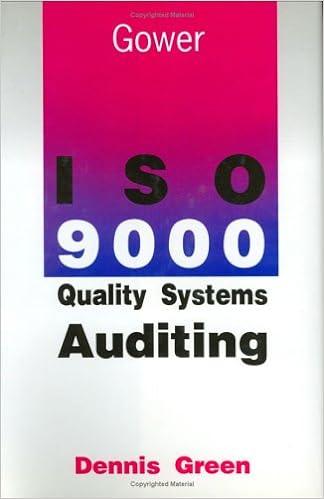Question
Allocating Purchase Price Including In-Process R&D Assume Adobe Systems, Inc., reports the following footnote to its 10-K report. During fiscal 2006, we completed the acquisition
Allocating Purchase Price Including In-Process R&D Assume Adobe Systems, Inc., reports the following footnote to its 10-K report. During fiscal 2006, we completed the acquisition of Macromedia, a provider of software technologies that enables the development of a wide range of Internet and mobile application solutions... The total $3.5 billion purchase price is allocated to the acquired net assets of Macromedia based on their estimated fair values as of December 3, 2005 and the associated estimated useful lives at that date:
| (in $000) | Amount | Estimated Useful Life |
|---|---|---|
| Net tangiable assets | $ 773,564 | N/A |
| Identifiable intangible assets | ||
| Acquired product rights | 265,500 | 4 years |
| Customer contracts and relationships | 183,800 | 6 years |
| Non-competition | 500 | 2 years |
| Trademarks | 130,700 | 5 years |
| Goodwill | 1,993,898 | N/A |
| Stock-based compensation | 150,951 | 2.18 years |
| Total purchase price | $ 3,498,913 |
(a) Of the total assets acquired, what portion is allocated to net tangible assets? (Round your answer to the nearest whole percent.) Net tangible assets =Answer% (b) Are the assets (both tangible and intangible) of Macromedia reported on the consolidated balance sheet at the book value or at the fair value on the date of the acquisition?
The assets and liabilities of the investee company are not reported on the investor's balance sheet. Instead, only the proportion of the net assets (equity) owned is reported.
All assets of the acquired company are reported on the consolidated balance sheet at cost plus or minus a fair value adjustment at each statement date.
All assets of the acquired company are reported on the consolidated balance sheet at their fair values on the date of the acquisition, not at their net book values.
All assets of the acquired company are reported on the consolidated balance sheet at market value on each statement date.
(c) How are the tangible and intangible assets accounted for subsequent to the acquisition?
Assets of the investee company are not reported on the investor's balance sheet. Reporting the tangible and intangible assets on the investor's balance sheet could lead to a double counting of assets leading to an over reporting of net income.
Assets of the investee company are reported at fair value on the investor's balance sheet. Since the investor and investee accounting practices are not identical, an estimation process using the fair value amount will be the most accurate.
Only tangible assets are reported on the investor's balance sheet. Intangible assets are excluded because they cannot be reliably measured. Since the investor and investee accounting practices are not identical, an estimation process would be required which would reduce accuracy.
Tangible assets are accounted for as any other acquired asset. Intangible assets with a determinable life are amortized (depreciated) over their useful lives, and intangible assets with an indeterminate life are not amortized, but are tested annually for impairment.
(d) Which of the following statements best describes the accounting for goodwill?
Goodwill is not amortized, but is tested for impairment at least annually.
Goodwill is not reported on the investor's balance sheet because it cannot be reliably measured.
Goodwill is initially recognized at fair value on the acquisition date and is subsequently amortized (depreciated) over its estimated useful life.
Goodwill is reported at historical cost as with all other assets.
Step by Step Solution
There are 3 Steps involved in it
Step: 1

Get Instant Access to Expert-Tailored Solutions
See step-by-step solutions with expert insights and AI powered tools for academic success
Step: 2

Step: 3

Ace Your Homework with AI
Get the answers you need in no time with our AI-driven, step-by-step assistance
Get Started


